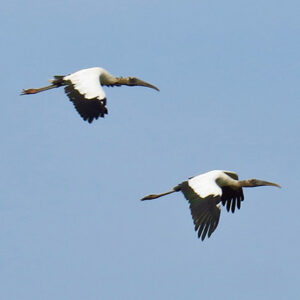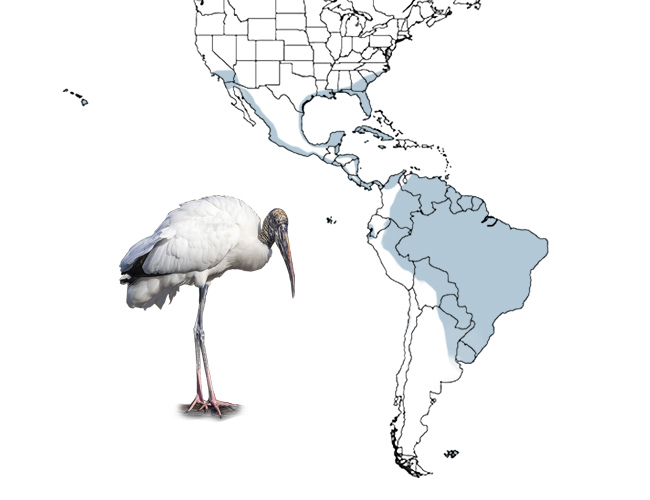Identification | Nesting | Feeding | Migration | Facts
Adults and juvenile wood storks migrate short to medium distances within its range. Movements of this kind monitor the availability of food. This article discusses several aspects of the wood stork’s movements.

- Most wood storks make regional movements
- Changes in food availability are the main reason for their movements
- Most South Florida birds move north after breeding
- Their movements are short to medium distance
- Some birds stay in one area all-year-round
- Wood storks leave Georgia, South, and North Carolina in the winter
- They move in small unorganized flocks
Do wood storks migrate?
The wood stork is not a migratory species in the strict sense of the word. However, they perform regional movements, mostly south-north and vice versa.
Wood storks move according to the rainfall pattern, which determines food availability. When environmental conditions lead to a lack of food, they move in search of better foraging grounds.
During times of food shortages, wood storks often abandon their breeding colonies leaving behind eggs and chicks in the nests.
Most of the movement occurs in the wood stork range after the breeding season. The juveniles and adults disperse mostly to the north, but many birds travel in all directions in search of optimal foraging grounds.
Wood storks return to breeding areas and may breed at the same colony or form a new one around areas where food is abundant. Some birds stay near the colonies year-round.
Wood storks usually return to the south to breed at the beginning of the dry season on the assumption that prey will eventually be restricted to small and shallow bodies of water where it is easy to catch.
Wood storks are not known to move outside the southeast region. There is no evidence that wood storks migrate from South Florida to Cuba. Wood storks do not fly over water since water does not produce thermals that they use extensively to move from place to place.
Also, there is no evidence that wood storks from the southeast US are the same population as wood storks of the southwest. Birds in the Southwest commute back and forth from Mexico.
Where do wood storks live?
Wood storks live roughly within latitudes 35 North and 35 South in all the Americas. They are widespread but occur in lowlands generally below 980 feet. They require flat and extensive terrain prone to cycles of flood and drought where prey are concentrated, and its tactile foraging strategy works best.
In South America, the wood stork is found in the flat lowland regions of all countries. They are absent from the Andean mountain chain and the dry Atacama Desert region of Peru and Chile, west of the Andes.
In Central America and Mexico, the wood stork is restricted to lowlands along the Atlantic and Pacific coasts.
In North America, the wood stork has its population stronghold in Peninsular Florida. It also occurs, in smaller numbers in Georgia, South and North Carolina, coastal Alabama, Mississippi, Lousiana, Texas, and part of Southern California.

Where do wood storks go in the winter?
This question only applies to the states of Georgia, South Carolina, and Coastal North Carolina, where wood storks leave in the winter. A few individuals stay in the region through most of the winter.
As a general rule, wood storks from these three states fly to South Florida in search of suitable foraging conditions. Other birds settle in closer areas in North and Central Florida.
A rough estimate of how far wood storks migrate. The distances were calculated from points where wood storks are known to breed to points where they regularly move after breeding.
| Wood Stork Movements | Distance in Miles |
| Mt Vernon (Georgia) to Corkscrew Swamp (Florida) | 493 |
| Grover (South Carolina) to North Everglades Nat Park | 531 |
| Lake Butler (North Florida) to Greenville (Alabama) | 330 |
Do wood storks migrate in flocks?
Wood storks do not migrate in flocks like common grackles and red-winged blackbirds.
Bird movements are triggered by food availability and generally result in birds leaving a particular area in small numbers when food conditions worsen.
The field observations of wood storks that were moving in one direction did not include many individuals. They seem to move in small and unorganized flocks.
Wood stork movements
The general consensus is that wood storks move north from the breeding colonies in South and Central Florida.
Storks that breed in North Florida disperse mostly to the west and north.
Birds that breed in Georgia move south or west from the breeding colonies. Many birds do not disperse after breeding and stay in the general area all year-round.
Is the wood stork considered a migratory bird?
Under the general sense of the word, the wood stork is not a migratory bird. A migratory bird is one that migrates/moves from one place to another at regular and predictable intervals, over long and short distances.
The wood stork is considered a “migratory bird” under the Migratory Bird Treaty Act’ (Act) definition. Under this Act, a migratory bird must meet one or more of the following criteria:
It occurs in the United States or U.S. territories as the result of natural biological or ecological processes and is currently, or was previously listed as, a species or part of a family protected by one of the four international treaties or their amendments.
Revised taxonomy results in it being newly split from a species that was previously on the list, and the new species occurs in the United States or U.S. territories as the result of natural biological or ecological processes.
New evidence exists for its natural occurrence in the United States or U.S. territories resulting from natural distributional changes and the species occurs in a protected family.
Accordingly, all bird species native to the U.S. including the wood stork, are considered migratory birds and are protected under the Migratory Bird Treaty Act.
Do wood storks use different habitat types in different regions?
Everywhere they go, wood storks use similar habitat types. In some regions, they may use certain habitat types more than in others, but overall, habitats are very similar.
After breeding, the wood stork tends to migrate along Florida’s east and west coasts. During the time when they make stopovers, they may use tidal wetlands more frequently. In some cases, individuals have been observed foraging in tidal wetlands during low tide and moving to freshwater wetlands inland for the remainder of the day.